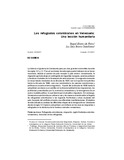Los refugiados colombianos en Venezuela: Una lección humanitaria

Visualizar/
Data
2020-01Palabras Clave
Refugiados colombianos, Migración, Región fronteriza colombovenezolana, Derechos de los refugiadosColombian refugees, Migration, Colombian-Venezuelan border region, Refugee rights
Metadatos
Mostrar registro completoResumo
La historia migratoria de Venezuela pasa por dos grandes momentos durante
los siglos XIX y XX. Para el comienzo de este siglo puede hablarse de un tercer
momento, debido al cambio de país receptor a país emisor. Inicialmente, la
migración agrícola atrajo un contingente de migrantes europeos, quienes poblaron
y fundaron ciudades de la Venezuela de este entonces. Un segundo momento
se inicia desde mediados de la década de 1920 con la irrupción del petróleo
hasta la década de 1990, con una combinatoria de razones económicas y
políticas en cuanto al tema migratorio. A partir de la década de 1990 hasta la
actualidad, se observa un cambio en la direccionalidad de las migraciones, los
problemas presentados por la economía venezolana y la emergencia de un
nuevo modelo político, lo cual disminuyó el atractivo migratorio. Sin embargo,
Venezuela experimenta por primera vez y de manera considerable la llegada
de refugiados colombianos a las regiones fronterizas y otras ciudades del
país, huyendo del conflicto armado y sus diferentes manifestaciones. El objetivo
de este artículo es analizar las diferentes etapas de la inmigración en Venezuela
desde el siglo XIX hasta la actualidad, con énfasis en los nuevos migrantes o
refugiados en la dinámica de la frontera colombo-venezolana.
Colecciones
Información Adicional
| Otros Títulos | The Colombian refugees in Venezuela: A humanitarian lesson |
| Correo Electrónico | ludarycast@gmail.com |
| Editor | SaberULA |
| ISSN | 1856-349X |
| Resumen en otro Idioma | The migratory history of Venezuela goes throught wogreat moments during the 19th and 20th centuries. For the beginning of this century, we can talk about a third moment, due to the change from receiving country to sending country. Initially, agricultural migration attracted a contingent of European migrants, who populated and founded cities in Venezuela at the time. A second moment begins from the mid-1920s with thee mergence of oil until the 1990s, with a combination of economic and political reasons regarding the migration issue. From the 1990s to the present, there is a change in the directionality of migrations, the problems presented by the Venezuelan economy and the emergence of a new political model, which diminished the migratory attractiveness. However, Venezuela experiences for the first time and in a considerable way the arrival of Colombian refugees to the border regions and other cities of the country, fleeing the armed conflict and its different manifestations. The objective of this article is to analyze the different stages of immigration in Venezuela from the 19th century to the present, with emphasis on new migrant sorrefugees in the dynamics of the Colombian-Venezuelan border. |
| Colación | 31-54 |
| Periodicidad | Semestral |
| País | Venezuela |
| Institución | Universidad de Los Andes |
| Publicación Electrónica | Cuadernos sobre Relaciones Internacionales, Regionalismo y Desarrollo |





